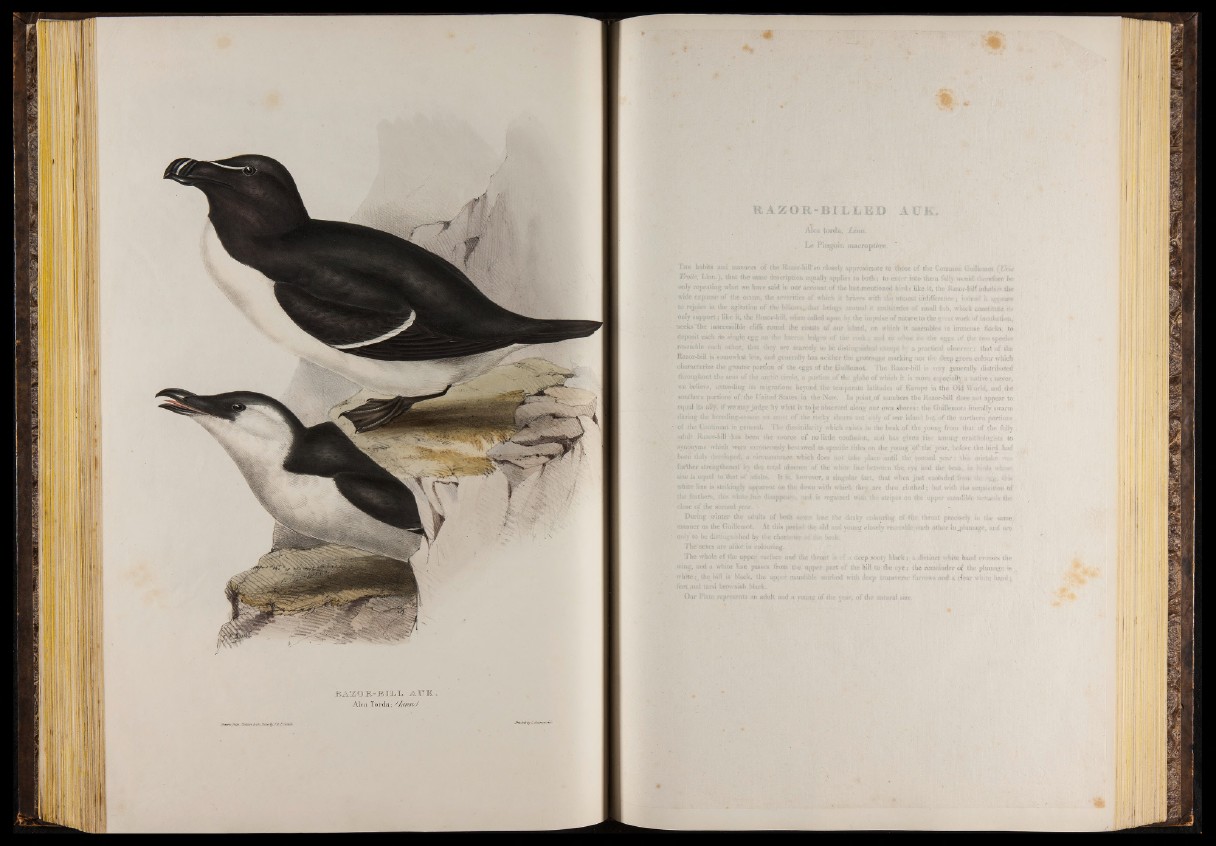
J R A Z 0 R -B IX.HL» A F K ,
ALca Torda; fZintv.J
R A Z O R -B I L L E D AUK,
Aka torda,
Le Pingom croptere.
I he habits and manners of the Razor-bill'so closely approximate to those of the Common Guillemot ( Uria
Trvilfi, Linn.), that the same description equally applies to both; to enter into them fully worddifi.refore He
only repeating what we have said in our account of the last-mentioned birds like it, the Razor4«$ inhabit * the
wide expanse of the ocean, the severities of which it braves with the utmost iadifiereijce; m M U ;-,puears
to rejoice in the agitation of the billow*» that brings around it multitude« of small fish, which constitute its
only support; like it, the Hazor-bill, wiieti called ujkhi by the impulse of nature to the p work of incuiHetUxi,
seeks the inaccessible cliffs round the cotists of ow island, on which it assembles in immense Socks,. to .
deposit each its single egg on the barren ledges' of the rock ) ««d so the eggs of tf;r two specm*
resenible each other, tbat they are scarcely to be distinguisltts? dgnepfr ?«••• a practical observer * tfuit <*-t the
Razor-bill is somewhat less, and generally has neither the grdtcsmje marking uor the deep green colour which
characterize the greater portion of the eggs of the Guillemot. The Razor-bill is very generally distributed
throughout the seas of the are tic circle, a portion o f th- globe o f which it is more especially a native; never,
We believe, extending its migrations beyond the temperate latitudes of Europe in the Old World, and the
southern portions of) the United States in the New. In point.of numbers the Razor-bill does not appear to. .
equal its ally, if we may judge "by what is to be observed along our own shores: the Guillemots literally swarm
during the breeding-season on most of the rocky shores not only of oar island but-of the northern portions
o f the Continent in general. The dissimilarity which exists in the beak-of the young from that o f the fully
adult Razor-bill has been the source of no little confusion, aod has given rise among ornithologists to
synonyms which were erroneously bestowed as specific titles on the young of "the year, before the bird had
been ‘duly developed., a circumstance which does not take-place until the -second year : this mistake was
further strengthened by the total absence of the white line between the., ere and the bonk, iw birds,
SU% is equal toilhst o f adults, Itfet, however, a singular fact, that when just excluded few» . ^ . t|jfc
white line is strikingly -apparent ou the down with which they are then clothed but wir.li the acqniskfOi* Of
the feathers, this white line disapgKsuh*. iuid is regained with the stripes on the upper mandible ioWar.in the
dose of the second year.
During winter the adults of hoih >IMrtii' tone the dusky colouring of #»c throat precisely in the same
manner as the Guillemot. At this period tite did an d young closely re&ci^ifefe: enrh other iu_pluaiage, and are
only to be distinguished by the character «-s die hcAk.
The: sexes are alike1 in colouring.
The whole o f the upper surface and the throat ’» o f deep soot) black : a distinct white bami crosses the
wing, and a white line passes from the upper part of the bill to the eye; the remainder of the plumage is
white the bill is black, the uppef mandible marked wi$i w e » itflipsversfvfurwiwa and a clear white,'Hkisd.j
feet and tarsi brownish, black.
. Our Plate represents an adult and a young o f the yeair, o f the natural size.